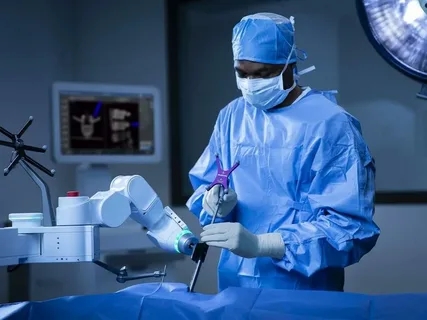Revolutionizing Knee Surgery: The Benefits of Robot-Assisted Knee Surgery

Knee surgery has traditionally been a challenging treatment and poses a list of risks to patients and very often requires recovery periods that seem to be too lengthy. However, the way that orthopaedic treatments are being performed has become completely revolutionised by robot-assisted knee surgery since the evolution of technology within the medical discipline. This current technology provides benefits to patients when it combines precision from robotic systems with the professional expertise of highly trained surgeons. Due to its higher precision, faster recovery, and improved results, robot-assisted knee surgery is increasingly being performed. The seven major advantages of robot assisted knee surgery, which are changing the very face of orthopaedic treatments, will be discussed in the article below.
Benefits of Robot-Assisted Knee Surgery
1.Accuracy and Precision Enhancement
The biggest advantage of robot-assisted knee surgery is certainly the increased accuracy and precision provided. The main purpose of robotic technology in the process of knee surgery is to allow the surgeon to complete the treatment with a degree of precision far higher than would be possible by using only the human hand. He can make very accurate incisions and alignments thanks to the robot's real-time imaging and feedback. In the case of knee procedures, accuracy is especially essential because even minimal departures from ideal alignment may bring about problems or undesirable results. The robot-assisted technology, therefore, supports the correct positioning of knee components, aiding in maximising the efficiency of surgical intervention and diminishing the possibility of problems.
2.Less Tissue Damage and Small Incisions
Smaller incisions are necessary for robot-assisted knee surgery relative to conventional knee surgery methods. The surgeon could perform smaller cuts with the robotic arms' minimal-invasive layout, incurring less damage to the tissue surrounding it. Less blood loss, injury to the soft tissue and muscle, and infections are all associated with smaller incisions. In addition, the smaller wounds heal faster, which lowers the possibility of problems. Patients might experience fewer discomforts after the operation and would have a more rapid recovery due to this.
3.Reduced Recovery Time
A major source of anxiety for patients having knee surgery is the period needed for recuperation, particularly for those whose period of time off from work or other regular activities is considerable. One of the advantages of performing knee surgery by using a robot is that periods for recovery are significantly faster. Patients often recover from surgery more quickly and with less discomfort because of the smaller incisions, less tissue damage, and more accuracy throughout the treatment. Robot-assisted knee surgery often results in shorter hospital stays and allows many patients to begin walking with help within hours after the treatment. Compared to standard surgery, patients may resume their daily activities and routines considerably sooner because of this accelerated recuperation.
4.Reduced Complication Risk
The other significant advantage of knee surgery assisted by a robot is that it has an immensely lower risk of complications. As the surgery is precise and less invasive, there is an immensely lower risk of infection, blood clots, or damage to nearby tissues. Additionally, the advanced robotic systems imaging that is developed reduces the possibility of surgical mistakes because one can evaluate the knee more closely in advance before the incision is done. The surgeon can plan the treatment better and safely if they have a better understanding of the anatomy of the knee. The studies have shown that the total complications of robot-assisted knee surgery are lower as compared to other traditional knee operations.
5.Personalisation for Every Patient
Because each patient's knee structure is different, what works for one person may not work for another. The highly customised treatment plan can be achieved through robot-assisted knee surgery. The robotic system generates the patient's and his unique anatomy of the knee with 3D imaging and computer software to produce a customised surgical plan. By then, the surgeon positions the knee implant correctly for optimum output and can then adjust the surgical technique to fulfil the needs of the patient. This degree of personalisation may enhance the knee joint's long-term functioning and contribute to the overall success of the procedure.
6.Increased Contentment of Patients
A significant benefit of knee surgery with robot assistance is the increased degree of patient satisfaction. Compared to conventional knee procedures, patients usually express more pleasure because of the procedure's accuracy, low invasiveness, and speedier recovery. Most patients recover sooner, return to work sooner, and experience less pain postoperatively. In addition to these mechanical benefits, more patients are content with the overall result because robot-assisted knee surgery has such a high rate of success and instils faith in the movement and function of their knee once again. An enhanced quality of life for patients after undergoing knee surgery calls for the fusion of psychical and physical benefits.
7.Improved Outcome at Long-term Follow-up
Other than contributing to faster recovery, the robot-assisted surgical process of the knee ensures superior outcomes at the long-term follow-up. Accurate and precise alignment of the implant and knee joint during the process would assure better performance by the knee post-surgery. Apart from increasing mobility and reducing the possibility of future problems such as implant loosening or misalignment, proper alignment may also reduce the possibility of wear and tear on the knee joint. Research has shown that patients who undergo knee surgery with the assistance of a robot generally have better long-term outcomes, including higher survival rates for implants and fewer revision surgeries later on. Robot-assisted knee surgery may, therefore, help patients lead better lives for years after the treatment.
Conclusion
Robot-assisted knee surgery is arguably one of the biggest developments the orthopaedic medicine field ever had, most especially since this boasts of some advantages over surgical methods. Robot-assisted knee surgery and hip revision surgeon has revolutionised knee surgeries using higher efficiency and precision, quicker recovery periods, decreased risk of issues, and better long-term results. Patients who choose to have knee surgery using this creative technique could anticipate a quicker recovery, less pain, and an increased likelihood of success. With all of these advantages, it is readily apparent anyone looking for a safer, more successful, and easier knee surgery procedure should choose robot-assisted surgery for knees.
What's Your Reaction?
















.jpg)

